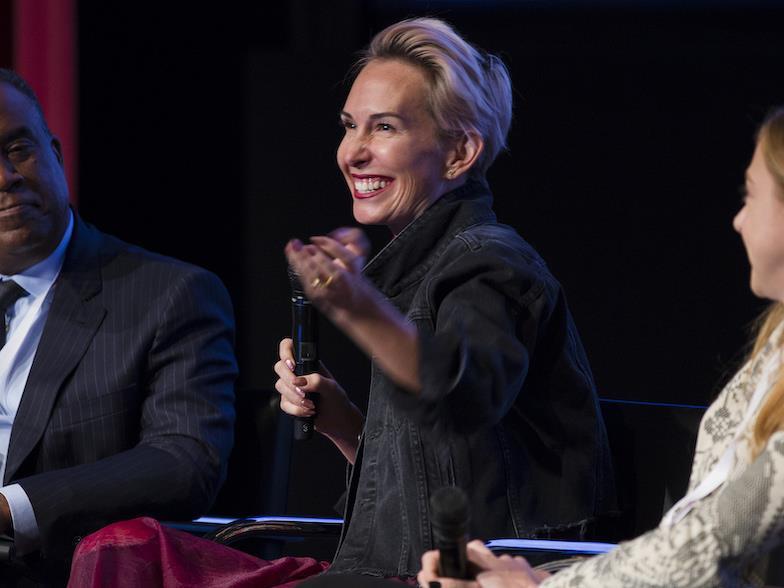Allison Agsten, former director of the Main Museum Los Angeles, Communicating the Museum 2017, Los Angeles. Photo credit Mary Funsten.
Cultural leadership isn’t just about leading an arts organisation or company; it’s about shaping and leading culture itself – making work that shows us how to live in an ever-changing world, as well as the nuts and bolts of sustainable and best-developed practice.
Which is why, according to conference organiser and founder of the international arts company Agenda, Corinne Estrada, it’s such a hot topic. ‘The sector is hard pressed to find a bigger buzzword right now,’ she said.
So what does it mean to be culture-led; what’s our social responsibility as cultural organisations, and how does one remain innovative while embracing best practice?
These and other questions will be discussed at the 24th Communicating the Arts Conference (CTA) to be held at the Australian National Maritime Museum in Darling Harbour from 12-14 November 2019.
‘It is a very big topic here, and I see Australia as having quite a different approach to Europe and America,’ continued Estrada.
Estrada believes that Australia is demonstrating great successes in cultural leadership, which is why over 300 international delegates will descend on Sydney in November.
‘Europe is very patriarchal, whereas Australia is less about title and more about expertise. Getting to that mindset is a great lesson to share with our global colleagues,’ she told ArtsHub.
Why you can’t afford to get communication wrong
In a time of unprecedented progress and deepening social division, the pressure is on arts institutions around the world to champion sustainable, collaborative and innovative strategies, all while anticipating for unknown futures.
Good leadership – and good communication – is critical.
‘I feel like the big topic of the day is activism, and museums and organisations have to take part, to have a voice. They are no longer just places to show culture, but have to become places of activism in our social culture,’ said Estrada.
The 19 year success story of Communicating the Arts lies in the conference’s format. Delegates hear from directors, communication and marketing specialists, engagement experts and entrepreneurs from all over the world, who share best practice examples of dealing with such thorny and fluid concerns.
‘Our Masterclasses are very much an exercise of collective intelligence – you listen, you share and then you explain how you are going to implement it. We look at what is going on outside and then we say how do you bring that home – it is always about how you could do it differently in your organisation,’ Estrada explained.
‘What that means for Australian arts professional is that they sit at the table with major international colleagues on equal footing,’ she added.
For registration information visit www.agenda.com
As John Giurini, Assistant Director Public Affairs at J. Paul Getty Museum said: ‘Everyone here is top of their field – the best of the best.’
Jennifer Francis, former Marketing and Communications Director Louvre Abu Dhabi agreed, adding: ‘It is the only forum in the world I know whereby communicators can come together and talk about issues facing us in museums from a marketing and communication standpoint.’
But learning is a two-way street, especially in our digitally-driven world. This year CTA has initiated a new project that will bring 30 arts professionals under the age of 30 to the table for free, so that our next generation of cultural leaders are bought into the fold of this global network, and its rich learnings.
Estrada said that when they started CTA 19 years ago, it was just the big players – the Tate, Kunsthistorisches Museum, the Louvre, the Getty – sharing best practice examples, but every year they are discovering very good cases that demonstrate how fast professional development is moving forward, at every level.
‘We invite small organisations on stage as well because they are very dynamic; they are rolling things out with very high expertise and limited funding,’ said Estrada.
It is the reason why, after 19 years, Communicating the Arts is expanding beyond the museum, gallery and heritage sector to embrace the performing arts.
‘All arts companies can learn from their business model; they are under big pressure to deliver – they have to fill the room every night; they have to be really sharp on their analysis and marketing, and they are very good in collaboration,’ Estrada said.
She believes that theatres are less caught up in the new game of being entertainment parks in comparison to museums.
‘Audiences for performed works are very demanding. There are no phones to distract them, they can’t just leave the room, and yet they continue to buy tickets and come back for that experience.’
Karilyn Brown, who heads up NIDA’s Cultural Leadership course, believes leadership has a lot to do with trust.
‘The core principles in good leadership have remained the same. Trust, preparedness for risk, vision, integrity – they are still what makes for a really great leader,’ Brown said.
There is one further ingredient, Estrada added: ‘When you talk to someone it is all about emotion; you remember a person, you don’t necessarily connect with an email address. We are coming back to that human connection more and more, and in our sector, it is the emotional experience, the emotional connection that people are demanding.
‘What we are looking at in our organisations is a social environment, not just a place to visit via digital technology. Communication – real communication – is more vital than ever in getting it right.’
Communicating the Arts will be presented at the Australian National Maritime Museum, Sydney, from 12-14 November 2019. For ticket information and registration visit www.agenda.com





